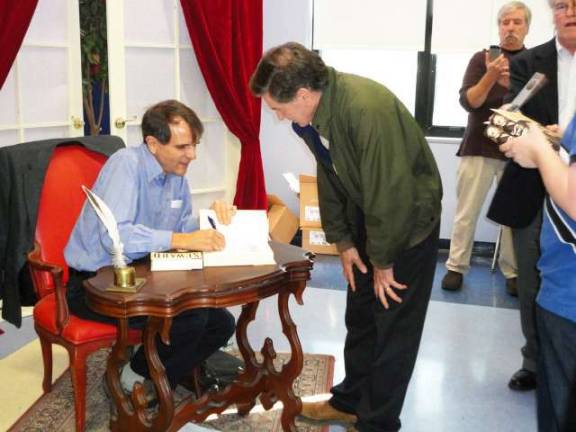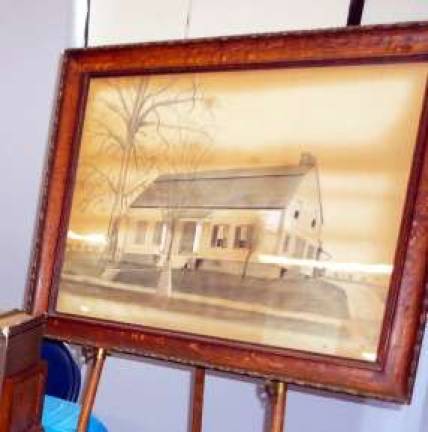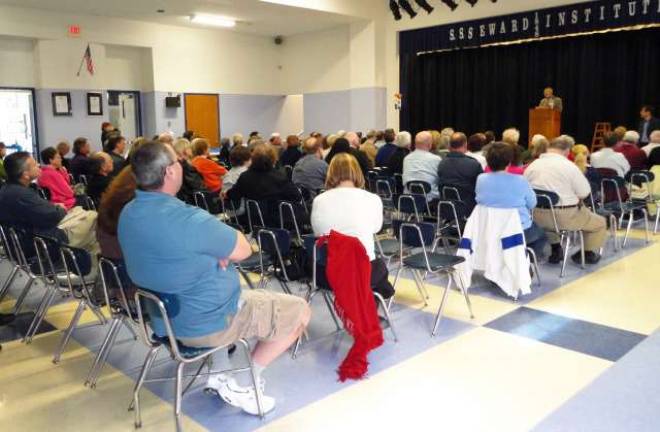Author brings Seward to life for locals



FLORIDA — More than 100 people entered the school named for William Seward’s father last Sunday, to hear about the famous son born and raised in this tiny village of Florida, N.Y. and destined to become “Lincoln’s Indispensable Man.”
And that is the title of the book written by Walter Stahr about Seward.
On behalf of the Seward Homestead Restoration Committee, Stahr gave a lecture to the packed cafeteria with standing room only. One could almost smell the cigars, of which, the author said, Seward smoked between six and 12 a day.
In good company
John J. Kimiecik, a retired English teacher from Seward and a member of the restoration committee, introduced Stahr to the attentive crowd. Stahr had researched Seward for three years before writing the book. Many who purchased the book had previously read Doris Kearns Goodwin’s book “Team of Rivals: The Political Genius of Abraham Lincoln.”
“Whenever you read about Lincoln, Seward’s name pops up and the fact that he lived here makes it even more interesting,” said Bob Balfour, a dentist from Goshen whose hobby is reading about the Civil War and who owns many books on the subject.
Stahr described Seward as one of those annoying kids “always raising his hand and knowing the answer. Most kids ran away from school, he ran to school.”
Anecdotes included tales about Seward and his father arguing about how much he spent on clothes while at college and relocating to Georgia to teach so that he could distance himself from his dad who was not only a doctor, but merchant and postmaster of Florida. He came back only at the urging of his mother, though his dad was also upset at his leaving. When he returned, he lived in Goshen and worked in a lawyer’s office and in New York City before passing the bar. He later wrote that the people of Goshen were “low, mean and groveling and wasn’t sure if their love or loathing was more desirable.”
Almost a president
Seward moved to Auburn to be closer to the state capital and joined every committee he could. In 1830, he was elected to the senate, in 1834 he lost the race for governor but won in 1838. Only his own Orange County had voted against him.
According to Stahr, Seward went on a quest for a more standardized school system for Catholic children in a public school system dominated by Protestants. He also spoke of his desire for roads and railways binding the nation together, more for uniting the country rather than for economic reasons.
Stahr said Seward was labled an abolitionist when he refused to return three southern slaves who escaped to New York, saying that there was no slavery here. He was also criticized for wanting a higher law than the Constitution when he opposed the Compromise of 1850, though it was passed anyway.
Seward is credited not only with the purchase of Alaska, Stahr said, but for laying the groundwork for all of the territories acquired by the United States afterwards as well. Stahr said Seward lost the presidential nomination to a lesser known Illinois attorney named Lincoln. The reason he lost, Stahr said, was that Lincoln’s friends disadvantaged Seward by distancing New York delegates from other doubtful delegates. Lincoln had agreed to allow existing slavery to continue while it was thought that Seward would try to end slavery, causing southern states to secede.
A "great friendship"
The author described Seward’s relationship with Lincoln as one of great friendship, once Seward got over the disappointment of losing the nomination to him. He realized that Lincoln had qualities that he himself didn’t have and that he could be a great help to him. It was said that Lincoln often sought Seward’s company after dinner and that as the two would enter a meeting together, it was obvious from the smiles on their faces that the two had already agreed on matters beforehand.
After the lecture, the crowd asked questions. “What was Seward’s reaction to Lincoln’s death?” asked one who attended. Seward, who had survived an attack on his own life that same night and saw flags at half mast outside his window, told an aide, “He must be dead because if he were alive he would have been the first to come see me.” Then Seward wept.
Loving their history
“We rocked!” exclaimed one of the committee members who organized the event after seeing such a turnout. Last Sunday was the same day as Warwick's Applefest.
“This community takes its history seriously,” said Diane Munro, superintendent of Florida Schools who attended the event.
There were long lines to sign the guest book and of people waiting to purchase the newly released book. There were photos of the progress being made at the site of Seward’s birth in the village, photos of Seward at various stages of his career, floor plans, a portrait and an actual model of the building on the homesite.
Copies of the book are available through the Seward Homestead Restoration Committee by visiting the Web site (www.sewardhomestead.org/events). Money raised by book sales through the Seward Homestead Restoration Committee will help fund the restoration.